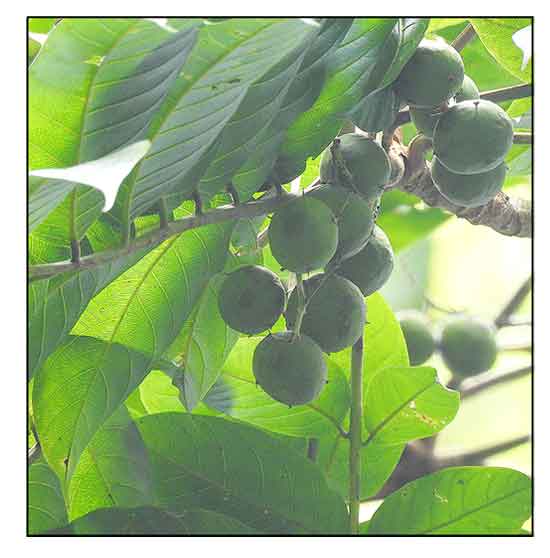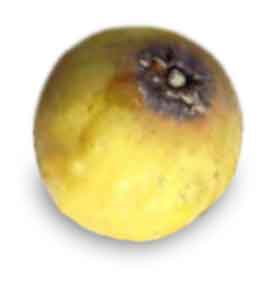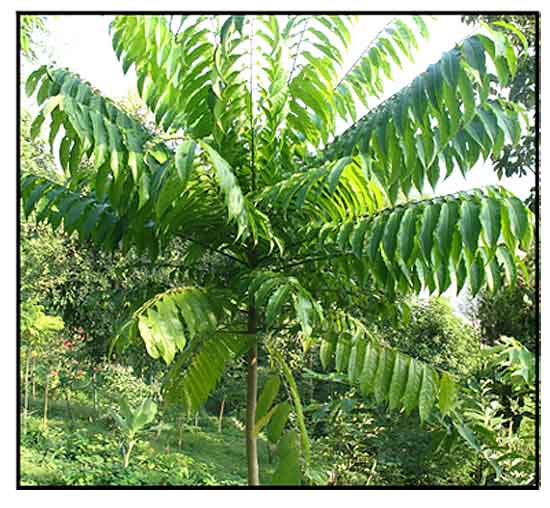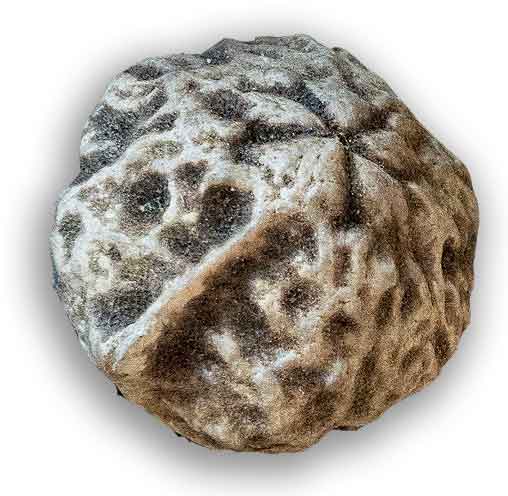 Gen info Gen info
- In the Philippines, the municipality of Dao, Capiz and barangay of Dau in Mabalacat, Pampanga are named after the dao tree.
- Etymology: The genus name derives from Greek words for drago (dragon) and melon, referring to the fruit. The species epithet dao derives from the Philippine vernacular name for the tree.
- Revered and called "Five Buddhas" in Thailand and in Laos because of the intricate pattern of approximate five-fold symmetry on the seed surface and its rhombic protrusions that reminds of the primitive Buddha image. (10)
Botany
• Dao is a large tree, growing 30 meters or taller, with the trunk 1 meter or more in diameter. Leaves are alternate and pinnately compound. Leaflets are smooth, oblong, 5 to 7 pairs, up to 15 centimeters long and 4 centimeters wide, pointed at the apex, and abruptly tapered at the base. Flowers are small, white, and fragrant, hanging in lax panicles. Fruit is globose, green turning yellow when ripe with oval markings on the upper side of the fruit, about 2 to 3 centimeters in diameter.
 • Quisumbing's compilation lists D. dao and D. edule as synonyms. The Philippine Native Forest Trees site lists Dracontomelon edule as a separate species, Lamio. Lamio looks very much like Dao when small; however, when it grows, the fruits, seeds and leaflets will be larger. Lamio's bark is brown while Dao's is somewhat creamy. (8) • Quisumbing's compilation lists D. dao and D. edule as synonyms. The Philippine Native Forest Trees site lists Dracontomelon edule as a separate species, Lamio. Lamio looks very much like Dao when small; however, when it grows, the fruits, seeds and leaflets will be larger. Lamio's bark is brown while Dao's is somewhat creamy. (8)
Distribution
- Native to the Philippines.
-
Previously common and widely distributed in forests throughout the Philippines.
- Occasionally planted as a shade tree or roadside ornamental.
- Now becoming rare.
- Also native to Andaman Is., Bangladesh, Bismarck Archipelago, Borneo, Cambodia, China South-Central, China Southeast, East Himalaya, Jawa, Laos, Lesser Sunda Is., Malaya, Maluku, Myanmar, New Guinea, Nicobar Is., Solomon Is., Sulawesi, Sumatera, Thailand, Vietnam.
 Constituents Constituents
- Essential oil from the skin of stems yielded 13 compounds accounting for 100% of the EO. The major constituents were n-Hexadecanoic acid(46.13%);Octadecanoic acid (15.44%), (E)-9-Octadecenoic acid (13.73%), and (Z,Z)-9,12-Octadecadienoic acid (7.79%). (2)
- Study of twigs isolated
cardol (1), β-sitosteryl-3β-glucopyranoside-6'-O-fatty acid esters (2), β-sitosteryl fatty acid esters (3), and a mixture of β-sitosterol (4a) and stigmasterol (4b) from the petiole; 1, a mixture of 4a and 4b, anacardic acid (5), triacylglycerols (6), monoacylglycerol (7), long-chain fatty acid esters (8), and linoleic acid (9), while the flowers yielded a mixture of 4a and 4b, 5, 6, 8, long-chain fatty alcohols (10), and long- chain hydrocatbons (11). (13)
Properties
- The sap of the tree may be irritation and/or poisonous.
-
Fruit is considered cooling, antidote, depurative.
- Studies have shown antibacterial, antifungal, antioxidant properties.
Parts used
Fruits, seeds, bark.
Uses
Edibility
- Fruits are edible, sour when fresh or stewed in honey.
- Kernel of the seed is also edible; mixed with tea it imparts a fragrant and mucilaginous sweet taste.
- Flowers and leaves cooked and eaten as vegetable; used as food flavoring. (7)
 - Fruit is an ingredient in some Vietnamese dishes; dried and preserved as a snack or made into a syrup for mixing in cold drinks. - Fruit is an ingredient in some Vietnamese dishes; dried and preserved as a snack or made into a syrup for mixing in cold drinks.
- The sour-sweetish fruit is cooked with soy sauce and eaten with rice, or used for flavoring curries. (10)
Folkloric
- A decoction from the stem of the Lamyo is drunk by the Ayta people of Bataan for treatment of wound infections. (10)
- Bark used as abortifacient. Also used for treatment of dysentery. Fruit is depurative and used for treatment of dermatitis. (10)
- In China, fruits used to cool and relieve itchiness; cure internal ulceration, and as antidote for poisoning.
- Bark used for dysentery.
- Fruits used to soothe sore throat and inflammation of the skin.
- Indonesians drink a decoction of bark to expel the membrane enveloping the fetus in the womb.
Others
- Toys: Seeds used by children as toys.
- Fuel: Tree used as firewood.
- Wood: Wood is soft, moderately heavy, not very durable. Used for veneers, furniture, plywood, interior trim and light frames. (7)
- Superstition: Holding a seed in the right hand on odd days and the left hand on even days will precipitate childbirth.
Studies
• Antibacterial / Antifungal: Crude and methanol extracts and fractions of leaves, stem, and root barks exhibited a good level of broad spectrum antibacterial activity. Only the leaf fraction showed antifungal activity. (3)
• Antibacterial / Anti-Escherichia coli Activity: Study evaluated various extracts of D. dao leaves for anti-Escherichia coli activities. An EtOAc fraction exhibited the strongest anti-bacterial activity. (5)
• Black Teeth / Antibacterial Effect: Study evaluated the tooth-blackening procedure among Kammu women in Laos and Vietnam and its possible antimicrobial effects. Three plants commonly used were: Dracontomelon dao nuts, Cratoxylum formosum wood or Croton cascarilloides wood. Extracts of soot of the DD nuts inhibited the growth of salivary mutans streptococcus in in vitro experiments. (6)
• Antibacterial against MRSA (Methicillin-Resistant Staphylococcus aureus) and MDR E. coli / Stem Bark: Study evaluated the antibacterial activity of stem bark extracts against MRSA and E. coli MDR (Multiple Drug Resistance). MBC/MIC ratios for MSSA, MRSA, and E. coli MDR were lower than 4. Results suggest the stem bark extracts have potential for development as antibacterial agent against MRSA and E. coli MDR strain. (12)
• Flavonoid Combination / Antibacterial / Leaves: Previous studies have reported antibacterial activity of leaves against E. coli, S. aureus, P. aeruginosa, and B. subtilis. This study evaluated the correlation between flavonoids and antibacterial activities and the combined antibacterial activities ofthese flavonoids. HPLC yielded main flavonoids including luteolin, L-epicatechin, clanidanol, and quercetin. Antibacterial activities of the main flavonoids were luteolin > clanidanol > quercetin > L-epicatechin. Synergistic effects between luteolin and clanidanol and quercetin and luteolin were validated. (14)
• Antibacterial / Anti-E. coli / Flavonoids and Phenolic Acids / Leaves: Studies have shown different extracts of leaves, especially EtOAc fraction, yielded flavonoids and phenolic acids which exhibit potent antibacterial activities. In this study, all six samples from EtOAc fractions of leaves exhibited notable antibacterial activities, especially S6 with IC50 of 84.3 µg/mL, which was significantly lowere than other samples. (15)
• Antioxidant / Radical Scavenging Activity / Bark: Study evaluated methanol extracts and fractions of Dracontomelon dao bark for radical scavenging activity by DPPH assay. The ME and n-hexane, ethyl acetate and water fractions showed strong antiradical activity. The ethyl acetate extract showed strongest antiradical inhibition with IC50 7.11 ppm. Phenolic and flavonoid contents were 75.89 g QE/100 g and 58 g GAE/100 g, respectively. Correlations of radical inhibition and flavonoids and phenolic content were 81.6% and 66.51%. (17)
Availability
Wild-crafted. |

![]()




 • Quisumbing's compilation lists D. dao and D. edule as synonyms. The Philippine Native Forest Trees site lists Dracontomelon edule as a separate species, Lamio. Lamio looks very much like Dao when small; however, when it grows, the fruits, seeds and leaflets will be larger. Lamio's bark is brown while Dao's is somewhat creamy. (
• Quisumbing's compilation lists D. dao and D. edule as synonyms. The Philippine Native Forest Trees site lists Dracontomelon edule as a separate species, Lamio. Lamio looks very much like Dao when small; however, when it grows, the fruits, seeds and leaflets will be larger. Lamio's bark is brown while Dao's is somewhat creamy. ( Constituents
Constituents
